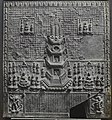Hase-dera (Sakurai)
The Hase-dera ( Japanese 長 谷 寺 ) in today's district Hase ( 初 瀬 ) of the Japanese city of Sakurai ( Nara prefecture ) halfway up the mountain Hase is the main temple of the Buddhist Buzan direction ( 豊 山 派 , Buzan-ha ) of the "New Shingon" Teaching “( 新 義 真言 宗 , Shingi-Shingon-shū ). The Hase-dera is the eighth temple on the Saigoku pilgrimage route .
history
There is no source documented date, according to tradition, the temple was founded in 686 by a monk named Dōmyō ( 道 明 ). The spelling of the name initially varied between 初 瀬 寺 and 泊 瀬 寺. The mountain name Buzan ( 豊 山 ) remained unchanged. At the beginning of the 8th century, the facilities were significantly expanded by order of the Tennō Shōmu . The current spelling was created in the course of this expansion. An eleven-faced Kannon statue was erected in the main hall and was inaugurated by the monk Tokudō. Since then, the temple has played an important role in the country's Kannon cult. However, over the centuries this hall has been destroyed by fires seven times. The present 9.3 m high figure dates from 1538 and, as the largest wooden statue of its kind, is an important cultural asset of Japan . Today's main hall as well as the bell tower were built in 1650. A number of administrative, residential and teaching buildings in the south-western part of the area date from the 19th and 20th centuries.
Already in the Heian period the temple was a popular place of pilgrimage for aristocrats and court ladies who made pilgrimages here from the imperial court in Heian-kyō . That is why the temple appears in works of court literature of the time such as the pillow book , the Genji Monogatari and the Sarashina Nikki .
The temple initially belonging to the Kegon School was later attached to the Hosso School . When the general Toyotomi Hideyoshi had the Negoro temple ( Negoro-ji , province of Kii ) belonging to the “New Shingon Teaching” destroyed, there were two leading monks among the refugees who sparked further divisions. One, Gen'yū (1529-1605), founded the Chizan branch ( Chizan-ha ), the headquarters of which is in the Chishaku Temple (Chishaku-in) in Kyoto. The second, Sen'yo (1530-1604), received the Hase-dera in 1587 from Hideyoshi's half-brother Hidenaga . The branch of the "New Shingon Doctrine" founded by him was named after the mountain name of the temple Buzan direction.
In the following years the Hase-dera developed into an important center for Buddhist studies.
Special features of the temple complex
The Hase-dera boasts many impressive sights. In contrast to the majority of Japanese temples, the various residential and devotional buildings are spread over a mountain slope. From the main gate, a covered stone staircase with 399 steps and many hanging lamps leads to the second largest main hall in Japan with the above-mentioned Kannon statue. From a wooden terrace in front of the main hall you have a good view of the complex and the valley. A copper relief ( Dōban Hokke sessō-zu ) from the 7th century entrusted by the temple as a loan to the Nara National Museum was declared a national treasure in 1963 .
Along the long staircase you pass several smaller halls. One of them, the Zaō Hall with three statues of the Avatar Zaō Gongen , indicates a connection to the Shugendō and the Kimpusen Temple in Yoshino. A seated sculpture of the avatar Akiba in front of the main portal of the temple documents the relationship to syncretic directions.
The hare-dera is most attractive during the peonies' blooming season in May. The temple owes its nickname to the peony temple to the beautiful flowers of over 7,000 plants in 150 varieties .
Important festivals and events
- February 14: The Dada-oshi ceremony is derived from a legend of the temple about demons in ancient times who tormented the people in the mountains. The demons were subdued by the spiritual power of the monks. In the ceremony the demons appear with burning long wooden torches and are pursued by the crowd.
- May: flowering time of the red, pink and white peonies planted in the extensive gardens
literature
- Valeria Jana Schwanitz and August Wierling: Saigoku - Out and about in Japan's western lands. Manpuku-Verlag, Potsdam, 2012, ISBN 3-9815168-0-X .
Web links
- Official Website - Japanese
- Buzan-ha website - Japanese and English
- Hase-dera on taleofgenji.org - English
gallery
Coordinates: 34 ° 32 ′ 9 ″ N , 135 ° 54 ′ 25 ″ E














